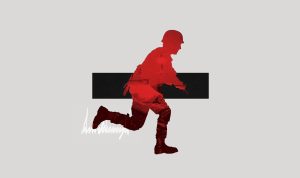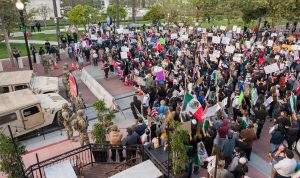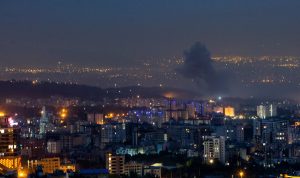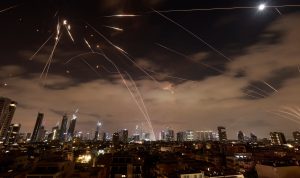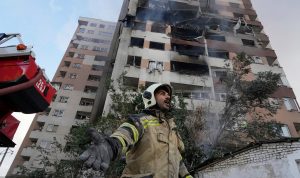Following the collapse, in early March, of the temporaryceasefirebetween Israel and Hamas, Israel essentially shut down all aid entering the Gaza Strip. The territory had already been facing ahumanitarian crisisfor nearly eighteen months. During that time, Israel allowed in a fluctuating, almost always insufficient number of aid trucks. The food and medicine that arrived on those trucks was then distributed by local groups across the Strip. In May, when the full blockade was partially lifted—after European leaders, and even the Trump Administration, warned of starvation—the old system of aid delivery, which was operated in part by the United Nations, was largely phased out in favor of a new organization called the Gaza Humanitarian Foundation, which was set up in coördination with Israeli authorities to deliver supplies to Gazans at just four locations.
Before the G.H.F. began its operations, the United Nations and a number of humanitarian organizations warned that the new system would lead to chaos, with people being forced to travel long distances to receive aid, potentially leading to dangerous crowds and violence. And indeed, during the last several weeks, Israeli forces have killed scores of Gazans at these sites, and injured hundreds more, as the death toll among those seeking aid from the G.H.F. has surpassed a hundred and twenty people. (Israel has acknowledged firing warning shots, as well as firing further shots at people who ignored the warnings.) The G.H.F., whose decision-making structure is opaque, has already changed its leadership and temporarily shut down operations to reëvaluate its procedures. At one point last weekend, G.H.F. said that it could no longer continue its work because of threats to its staff from Hamas. (Hamas has denied the accusation, and G.H.F. resumed operations the next day.)
I recently spoke by phone with Salma Altaweel, who lives in Gaza and works for the Norwegian Refugee Council, a humanitarian N.G.O. I wanted to get a sense of how her organization was dealing with the new aid system, and exactly what had changed on the ground since it was put in place. During our conversation, which has been edited for length and clarity, we also discussed how she talks to her daughter about the current situation, her concerns about the G.H.F., and what Gaza needs besides food and medicine.
Can you tell me what your job consists of right now and what your day is like?
Yes. I’m working as the field-office manager in the northern part of Gaza City. [Someone begins talking to her in the background.] Excuse me, it’s my daughter. Sorry. And now, since the ceasefire collapsed, we are working in hibernation mode. It’s very hard to move in Gaza City. But we are still providing support to people. We are providing drinking water to much of the population in the central part of the city. And we are providing clothes, through e-vouchers, to hundreds of families. There is not enough cash for people to buy merchandise, so we have been giving out vouchers to families in need. We make arrangements with certain venders, and then beneficiaries will receive a code that they can use to redeem clothes. We also have some learning spaces that provide informal education to kids. Also, we have a legal section that is providing some legal support and offering consultations.
How is drinking water accessed?
There are still some plants here in Gaza City that are working to provide drinking water. Trucks are moving around, travelling to shelters and providing water to people inside, and outside, too. We are covering a good number of people. And there are some other N.G.O.s doing this. All of them are collaborating with each other to try to cover most of Gaza.
I know that even before the blockade began in early March, there was never enough aid reaching the people of Gaza. But there was some aid. Can you talk about how aid reached Gazans under that system?
Before the collapse of the ceasefire, U.N. agencies and international N.G.O.s were working to try to coördinate aid. Not all items were allowed to enter Gaza, but as you mentioned there were some items that were entering. Trucks would cross the border, and the aid would enter the warehouses of the U.N. agencies and the N.G.O.s. After that, each local organization had its identification criteria to provide aid to people. The people were receiving text messages so they could come and collect it from the warehouse of the U.N. agency or the N.G.O. with dignity, and without a crowd. Also, aid would arrive to different neighborhoods, and people were not forced to move long distances or go to an insecure place to collect food, or shelter items, or hygiene kits, or whatever they were allowed to take. The quantities were not enough to cover people all the time, but at least there was some food that was entering. The bakeries were also functioning at some points—not all the time, but sometimes there was bread.
Then, in March, Israel announced that there would be a total cutoff in aid. How quickly did things change?
Many of the bakeries remained functioning for one month after March, but they closed by early April, and starting at that time most of the stock from the markets was empty. So by May we faced real starvation. People were not eating for days because there were not any items entering. They have resumed allowing some items, but not enough.
After this new aid system started, the one with the Gaza Humanitarian Foundation, what did your organization do? And what’s been happening more broadly? The stories we read in the United States are that people have to travel to this small number of sites to get food, and it’s obviously been very chaotic. The Israeli military has shot people. How is your organization trying to operate within this new system, and how do you feel the new system is or isn’t working?
Let me just say that, for the last few weeks, relocation orders have been issued and are covering most of Gaza. The N.R.C. specializes in providing shelter, and people are being forced to relocate to other places without taking their shelter items with them. In most cases, people are forced to flee only with what they can carry. Often, people are only given a few minutes’s notice to leave. So they are in high need of items such as tents, bedding sets, and clothes. They are moving without any of those items because they aren’t able to. And they are finding themselves out in the street without anything. We are trying to provide them support, but unfortunately shelter items are not coming through—until now, Israel was only allowing some specific items, like food and medicine. The U.N. is trying to push to get approval for shelter items, but we are not able to provide support to people who are in the streets sleeping without shelters.
So, just to be clear, the people relocating are relocating because the Israeli military is giving them orders to relocate, not because they are relocating to get food?
Yes, they are getting relocation orders because of military operations.
What are you and your organization telling people in terms of getting aid, and getting food? Are you providing them directions to get to the nearest facility where they are handing out food?
No, we are not giving them any directions like this. We are trying to do our best to support them, but we cannot give them direction to go to these areas. They are so risky. They’re killing people on a daily basis in those areas. There is no humanity in these areas. Humanitarian principles are not being applied. So we are not guiding anyone to go there.
So, for obvious reasons, because of the way the aid is being handed out and because people are getting killed at these distribution sites, you’re not telling people to try and approach the sites in any way?
So what advice are you giving people? I’m sure you must get asked by Gazans, “What should we do?”
Yes. We cannot give people advice to go to these sites. I can tell you that most people are not going. Many of the people who go are looters who are accessing those very risky areas to get items and sell them in the market at very high prices. This is what I can see on the ground.
And I assume there’s been no coördination between the Gaza Humanitarian Foundation and groups on the ground like yours?
A few weeks ago, we were hearing very serious warnings about starvation. Has any of the aid that’s come in during the past few weeks been circulating on the ground and at least made the situation a little bit better? Or is it the same situation in terms of lack of food and medicine that we were seeing a few weeks ago?
I think a very limited quantity entered through U.N. agencies. And some of that was looted. [On Saturday, Israeli authorities said that about fifty aid trucks per day had entered the territory during the prior week. According to an Israeli official who spoke toThe New Yorker,that includes aid delivered to the four G.H.F. facilities and aid brought in by other humanitarian organizations, who say that at least five hundred trucks per day are needed.] Because of all the starvation, the situation is not stable. Some people end up looting the aid. It was difficult to open enough bakeries when flour was looted. So, not enough of the aid is distributed. Some of the trucks have brought things that are not aid. This is on the commercial side. They are not essential items. They are like chocolate, cigarettes. Not flour.
Israel has allowed trucks with cigarettes to come into Gaza?
Is there a stated reason for this?
I don’t know. [When asked about chocolate and cigarettes entering Gaza, the Israeli official said, “I don’t know what you mean.” He later called back and said, “Commercial trucks have not entered the Gaza Strip.”]
So I guess your hope is that Israel starts allowing more trucks of humanitarian aid in, because the Gaza Humanitarian Foundation method seems to be failing?
Yes. We are hoping that they open things up, like they did under the previous system, and not only for food. Yes, we are in need of food, but also shelter items. They are not letting fuel enter. The hospitals are in need of fuel. So we have a real need to go back to the previous method.
If you feel comfortable, can you talk to me a little bit about how you personally are dealing with this? Your daughter said something a few minutes ago.
Yes, we are now facing a challenging time. For me personally, I try to push the mealtime as late as I can, so at least they are not sleeping while they are hungry. [Altaweel has three other children.] So I try to push the mealtime. You can only prepare one meal per day. A meal for a family can cost a hundred dollars. So most families are not able to prepare more than one per day. And people are not having meals every day—maybe for some it is every two to three days. They are not eating anything. There is no flour in the market. We are depending on other seeds like lentils and rice, and they all have very high prices. It’s very hard. My daughter, she is always telling me, “I want sweets. I want something sweet to eat.” But there’s no sugar. I can’t prepare much.
What do you tell a seven-year-old about this? How do you explain the situation? How do you talk to her about it?
Sometimes she asks questions that I cannot answer. Sometimes she’s asking me, mostly when there are air strikes around us, “Why are they doing that with us, why they are killing us?” It’s very hard to answer the questions, and mostly I try to say, “Be patient,Inshallah, hopefully the situation will be better soon.” We are praying to God that food will enter. But she asks: why they bombed our house, what we did to them, why I lost all of my toys and all my clothes. Sometimes she’s crying, and sometimes she cries while she sleeps, because she has lost everything. But it’s hard to answer these questions for her.
What does your daughter do while you’re working? What do other kids do while their parents are working?
There are no schools. They’re spending their day at home, doing nothing. Maybe they’re playing with their peers in the same building, but that’s it. But they are feeling very bad, because there is nothing from their previous life that they can do.
When you think back to the way that aid was being delivered in the previous system, was the major problem that there wasn’t enough getting through? Or was the major problem that it couldn’t be distributed as you wanted it to because it was a war zone?
If we return to the previous system, it’ll be better in terms of food. But the problem is that all of the Gaza Strip is destroyed and it needs to be rebuilt and reconstructed, and if it isn’t things won’t be better. They were only allowing food and some lifesaving items to enter, but they were not allowing any other items for the reconstruction or rebuilding of our schools. There weren’t school items, or teaching items. So if we return to the old system, it’ll not be enough for us, because we are aiming to rebuild Gaza, and to live on streets without rubble. They also were not allowing heavy machines in to remove the rubble.
And yet, as you said a few minutes ago, the old system would be a huge improvement on what’s happening now.
It would be an improvement, but it would not be enough. ♦

